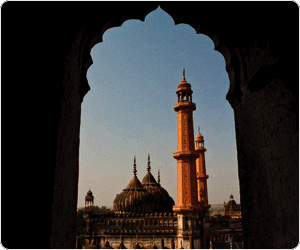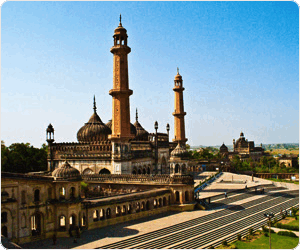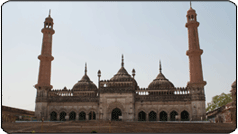
Asafi Masjid
Attractive Packaging is an important aspact for the sale of commodity. An Example can be seen in the book "Lucknow : Memories of a city" edited by the French scholar Dr. Violette Graff. The cover carried an attractive photograph of the first of the grand building constructed by the Nawabs when the capital of Awadh was permanently transferred from Faizabad to Lucknow by Nawab Asaf-ud-daulah in 1775. (Earlier his father Nawab Shuja-ud-Daulah had temporarily shifted the capital from Faizabad to Lucknow for about an year in 1764 and reverted it back to Faizabad in 1765).

According to Shia theologians, it is mandatory for the Pesh-lmam (one who leads the prayer i.e. namaaz) not to stand at a higher level than any of his devotees offering prayer. Since it was quite often, particularly during Friday prayers and annual mass prayers on the festival of Id and Baqrid, that the assembly of devotees swelled to such a large number that they had to be lined at ground level, below the steps leading to the high mosque, a solution to the problem of placing the Pesh-lmam aptly was found by putting him in a hollow space like a well that touched the ground.
There has been a period when the mosque was repeatedly defiled by the British, from July 1857 onwards upto June 20, 1884, when they used it as a gunpowder storage house and for placing guns and canons that attacked the rebel sepoys and citizens of the city who were faithful to the last King of Awadh, Wajid Ali Shah, whom the British deposed in February 1856 when he refused to sign his abdication from the rule of Awadh. Both the Asafi Imambara and its mosque were used by the British forces in this manner, while the nearby Alamgir mosque was being used as a medical aid centre for the soldiers.
It was twenty seven years later that a Shia mujtahid (religious leader) Syed Mohammed Ibrahim, respectfully honoured by the title of Shams-ul-Ulema (the sun amongst theologians), after repeated representations to the British government, could get the three religious buildings vacated from the British and offering of namaaz was re-started at the two mosques and Muharrum and other religious observances could be held in the Imambara.

Also, the practice of exclusive congregation of the Shia muslims for Namaaz-e-Juma and the annual namaaz for Eid and Baqridfestival was once again allowed in the Asafi Masjid.
Earlier, it was an ancestor of Shams-ul-Ulema, Syed Dildar Ali Naqvi of the village of Naseerabad (close to Jais, Rae Bareli district) who was better known posthumously by his title of Ghufran-maab, who led the first exclusive congregation (Jamaat) of prayers of Shia muslims on the birthday of Hazrat Ali on 13th Rajab 1286 Hijri (May 12, 1786 AD) followed by one for the weekly Friday prayers, two weeks later on May 26, 1786 AD. These congregations initially began at the mosque of Hasan Raza Khan titled Sarfaraz-ud-Daulah, the Naib (chief minister) of Asaf-ud-Daulah. Later they were shifted to the Asafi mosque , when it was completed, on the orders of the ruler, Nawab Asaf-ud-Daulah.
Interestingly, when the third King of Awadh, Mohammed Ali Shah (1837-1842) started the construction of his mosque, the Jama Masjid, on a larger scale than the Asafi Masjid, he ordered the shifting of the Friday prayers of the Shia sect to his mosque. But as destiny would have it, the lost glory and honour of the Asafi mosque was restored back to it in 1884, when the Nawabs were no longer in power.
Source :
Hindustan Times, A Bit of History
Wednesday 17.12.1997 — Asafi Masjid- A silent witness to history's turbulent passage

